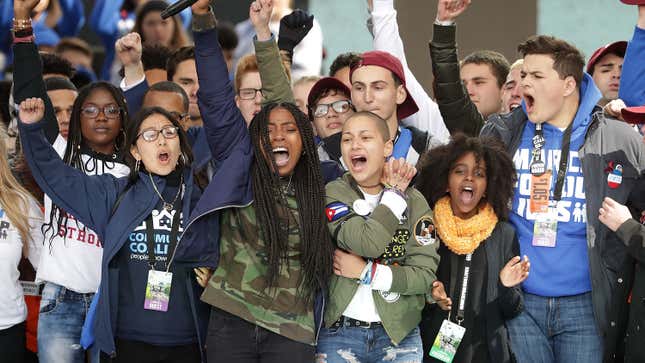The Parkland Survivors Can See American Gun Violence Very Clearly
Politics

March For Our Lives, the activist group founded by survivors of the 2018 school shooting in Parkland, Florida, unveiled a pretty comprehensive gun-control platform that calls for a massive overhaul of America’s response to the epidemic. The proposal calls for a number of changes, from raising the minimum age of purchasing a firearm to 21 and banning high capacity magazines to implementing a mandatory gun buyback program and installing a national director of gun violence prevention.
The Peace Plan for a Safer America, announced Wednesday, is being called the Green New Deal for guns, and the young authors behind it intend on making it a priority for the next president of the United States. As Parkland survivor Tyah-Amoy Roberts told the Washington Post, “We know and acknowledge every day that gun violence prevention is not just about preventing mass shootings.”
As such, the plan illustrates gun violence as a multifaceted American ill, one of spectacle and quiet pain, large political implications and smaller interpersonal traumas:
The next President must act with a fierce urgency to call this crisis what it is: a national public health emergency. They must acknowledge that the level of gun violence in the U.S. is unprecedented for a developed nation – and only bold, new solutions can move the needle on the rates of gun injuries and deaths. They must recognize that gun violence has many faces in our communities, from rural suicides to intimate partner violence to urban youth violence to violence driven by white supremacist ideologies. And they must commit to holding an unpatriotic gun lobby and gun industry accountable not just for weakening our nation’s gun laws, but also for illegal behavior in self-dealing that offends and contradicts America’s vast majority of responsible gun owners.
The Peace Plan is broken up into six-steps: Change the standards of gun ownership; halve the rate of gun deaths in 10 years; accountability for the gun lobby and industry; name a Director of Gun Violence Prevention; generate community-based solutions; empower the next generation. (Each proposal comes together to spell the word “change.”)
And infused into this is a legislation and regulation-heavy agenda that March for Our Lives believes will lead to a solid reduction in the distribution of firearms and firearm deaths.
“From a public health perspective, it should at least be as difficult to buy and transfer a firearm as it is to buy and transfer an automobile, in which decades of regulating cars led to a dramatic improvement in automobile safety,” the plan argues.
The plan also includes the following policies goals:
- A federal ban on assault weapons and high-capacity magazines.
- A multi-step approval process, overseen by a law enforcement agency, that requires background checks, in-person interviews, personal references, rigorous gun safety training, and a waiting period of 10 days for each gun purchase.
- A national gun buy-back and disposal program.
- Annual licensing fees for anyone who wants to obtain a national gun and ammunition license.
- A prohibition on any and all online firearm and ammunition sales or transfers, including gun parts.
- A requirement to safely store firearms, including implementing national standards for locking devices on guns.
- A federal policy to effectively disarm gun owners who have become a risk to themselves or others.
It’s worth noting that while the Plan mentions the need for expanded mental health services, it also emphasizes that mental illness is too often unfairly stigmatized in the gun violence debate (notably by President Trump): “Mental illness is not a risk factor for interpersonal gun violence; in fact, individuals struggling with mental illness are more likely to be victims of gun violence than offenders.”
Additionally, the Plan addresses an element often lost in the gun debate: policing. “We cannot talk about gun violence in communities without talking about our national challenges with police violence,” the plan reads. “While police violence both contributes to, and is influenced by, weak gun laws, we also need structural reforms that directly produce better policing.”
David Hogg—Parkland survivor, activist, and co-founder of March for Our Lives—told the Washington Post that he believes that Americans can unite around this ambitious set of goals. While specificities can be argued over endlessly, the trends can’t be ignored: Americans want more gun control, and recent polling following the El Paso and Dayton mass shootings indicate that a large majority of Americans support expanded background checks, gun buybacks, and a ban on semi-automatic firearms.
Naturally, the National Rifle Association hates this. Spokeswoman Amy Hunter has written off the Peace Plan entirely, saying: “The gun-control community is finally being marginally honest about their true wishlist. The simple fact remains their proposals and ideas are out of the mainstream, and most people will understand their real intent goes beyond what they publicly state.”
But Americans want something to be done about gun violence while the gun lobby and the politicians in its pocket are content with business as usual. It’s increasingly clear that the so-called “wishlist” of traumatized teens is increasingly more and more in line with the American mainstream.
This plan is one that should be taken seriously. All we need now are politicians who are actually willing to listen.